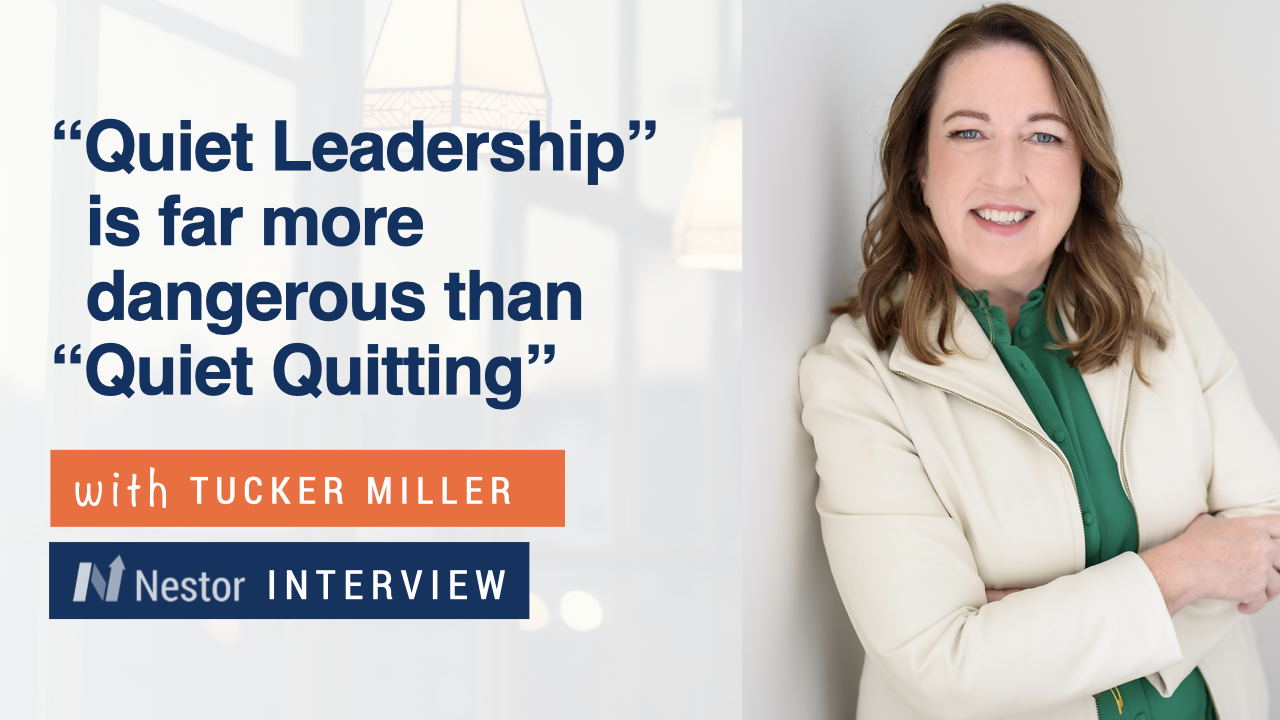What Is Quiet Quitting? Insights from an HR Expert
6 min read

With over 25 years of experience in human resources, leadership development, sales, and executive coaching, Tucker Miller, our guest for this interview, works with senior leadership teams to promote better communication, collaboration, and equity and is focused on helping women leaders accelerate their career advancement.
Tucker’s coaching practices emphasize self-awareness, understanding purpose, executive presence, building a positive leadership brand, goal alignment, and experimenting with new skills and insights.
In the following, we spoke with Tucker about the many debates surrounding quiet quitting and asked her to share her point of view about the leaders’ role in addressing this issue. You can connect with Tucker directly on LinkedIn.
What’s the economics behind quiet quitting?
Tucker Miller: Quiet quitting refers to a broader, viral phenomenon that extends beyond a company’s level. Quiet quitting is complex in its nature and multi-faceted. It references a response to individual and collective trauma, a call to action and social movement seeking justice and equality, and a bottom-up response to formerly top-down decision-making authority over workplace culture and expectations.
Adding to all of this is an uncertain economy. Others have identified that in the aftermath of “the great resignation” people are waking up to regret. While some are jobless, others who remained in their jobs are now feeling stuck and afraid to leave.
Quiet quitting brings a whole new meaning to paid time off. Rather than taking time to be physically away from work, employees may still show up as though at work but unplug by doing the minimum amount required of them, avoiding interaction, and being generally unavailable.
In pulling back their efforts, employees remain in their jobs, continue to be paid, and are not required to dip into their allotted days off. But are they really “on the job”?
How would you categorize a quiet quitter?
Tucker Miller: Let’s first acknowledge that quiet quitters haven’t quit their jobs. They are still showing up, still employed.
I am an advocate of finding appropriate space where employees can step back, repair, restore, and recover. For many, quiet quitting may serve as a time of healing and preparation, readying them to take action on what they want in life and work.
Is quiet quitting similar to chronicle disengagement in the workplace? Do you share this view?
Tucker Miller: Gallup has reported for years on employee engagement and there has always been a large portion of both disengaged and “actively disengaged” employees. Quiet quitting is similar to disengagement when we look at its collective impacts:
- lower productivity
- decrease participation
- increased absenteeism
- distrust
When we look beyond organizational impacts, quiet quitting is distinct from disengagement.
— Tucker Miller
For one, it speaks to a culmination of converging factors that include a global pandemic, a heightened call to action for justice and equity, and economic disruption and uncertainty.
One of the challenges in addressing quiet quitting is that it is not localized or specific to an organization. When we’ve looked at ways to increase employee engagement in the past, we’ve largely been able to focus on an individual company or organization – taking an inside-out approach to promoting trust, leader credibility, and open communication.
What are the challenges of quiet quitting at the organizational level?
The challenge of quiet quitting is that it may represent a prolonged period of indecision and underperforming.
— Tucker Miller
Tucker Miller: Underperforming over time results in other people stepping in to make decisions for you about whether you will continue to be employed or have new opportunities. As isolating as quiet quitting feels, it is not invisible.
People notice. Particularly when the level of contribution and engagement substantially changes. Too, quiet quitting is often symptomatic of a state of indecision and/or overwhelming, neither of which will open doors to a better future.
Is a quiet quitter comfortable with this situation?
Tucker Miller: Generally speaking, when people feel stuck, this situation often spirals into feelings of low self-esteem, unworthiness, or anger. It is very hard to pull out of these feelings and even harder to seek out new opportunities with that kind of mindset. In this way, quiet quitting may be contributing to results directly contrary to thriving in work and life.
The inclination to quietly quit may be appropriate in the short term to allow for self-reflection and restoration, but it is not an effective form of protesting unsatisfactory workplace expectations or standards.
— Tucker Miller
If there are changes employees want to see in their workplace or performance expectations, it is far more effective to engage and speak up with their leadership as opposed to staging or being a part of a “sit-in.”
Employers have more motivation than ever to listen to their employees and this is an ideal time to constructively engage in the dialogue regarding what needs to change. With staffing shortages and high turnover, the benefit of attending to employees has never been clearer and leaders know it.
How can leaders become an active part in counteracting quiet quitting?
Tucker Miller: For leaders, the phenomenon of quiet quitting may extend to them as well. Leaders are responsible for managing more than their teams, they are responsible for managing themselves as well.
While leaders need to avoid engaging in quiet quitting, more than ever it is imperative that they not engage in quiet leadership”
— Tucker Miller
If they see people begin to disengage, leaders need to reach out and see what’s going on, discover what help can be offered, and continually seek out ways to inspire, motivate and draw the team together. With leaders already feeling over-extended, this is a big ask – and yet it is too costly for individuals and the organization to address the heightened risk that comes from leaders quietly looking the other way.
Quiet quitting requires new things for both employees and leaders. And there is a category of circumstances that are outside of everyone’s control, which points to the need for new capabilities that we’ve not prioritized in the past:
- empathy
- agility
- resilience
- dealing with ambiguity
In fact, many leaders are faced with having conversations with their teams they are not prepared to have. We are now engaging with each other more openly, sharing parts of our private lives, “broadcasting” from our homes with pets and family members becoming integral to our combined work experiences.
While we may consciously know to avoid making assumptions, our brains are confronted with so much more “non-workplace” points of the input that it’s sometimes hard to know whether to lean in or step back.
Leaders are tasked with promoting belonging, and demonstrating caring for individuals while also ensuring that they maintain sufficient professional distance to ensure that they are making fair and equitable decisions. That’s a hard line to figure out, and it’s new. We are better together, and we’re still figuring out how to be better together as we move forward.
For additional opinions on quiet quitting, also check out: Triggers of “quiet quitting” and ways for HR and People Leaders to tackle it.










